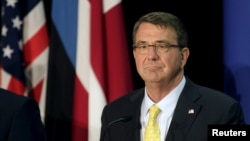The United States military is pushing for changes in strategy as it prepares for threats from state and non-states alike in the years ahead.
An analyst said the U.S. military is facing challenges in a unique time when threats from both extremist groups, such as the Islamic State, and nation-states, such as Russia and China, are on the rise.
U.S. Secretary of Defense Ash Carter told Army soldiers at the Fort Bragg base in North Carolina last week that the skills and experiences acquired during the counterterrorism wars in Iraq and Afghanistan can be applied to the new era.
Carter said the military is “moving into a different direction in the future, where we try to capture what we learned -- and we learned a lot in the course of those two wars, and to turn that skill and that experience to the kinds of conflicts that are going to determine our future.”
Nation-state threat
The Pentagon this month updated its National Military Strategy for the first time in four years.
The strategy warns the threat of war with another nation-state is low but growing, and lists several the U.S. military will pay more attention to, including Russia, Iran, North Korea and China.
Bryan Clark, a senior fellow at the Center for Strategic and Budgetary Assessments, a Washington-based security and defense think tank, said these countries are seeking their own security objectives and “our interests are likely to come into conflict in the near future.”
Clark, a former strategist with the U.S. Navy, told VOA the fact Russia has been taking a much more aggressive approach in East Europe and China in the South China Sea are among the determining factors in the strategy shift.
“Both of these two countries’ efforts have caused the U.S. to rethink the need to be prepared for ‘major power conflict,’ if you will, rather than simply focusing on counter terrorism problems,” he said.
China as adversary
While the report lists Iran, Russia and North Korea as aggressive threats to world peace, it frames the situation with China differently.
The strategy states the U.S. wants to support China’s rise and encourage it to become a partner for greater international security. But that does not mean the document underplays the risks of conflict with Beijing.
Clark said the military “definitely sees China as a much more significant threat to U.S. national security interests, because China is much larger economically, larger in terms of population, has a large and growing military, also has some of the high-end military capabilities that Russians have, but has them in large numbers.”
“China is also pressing its case directly against the U.S. allies in the region," he added.
War on multiple fronts
The Pentagon strategy calls for the ability to wage a large-scale and multi-phased war against an adversary in one region while denying objectives of another aggressor in another region.
Secretary Carter said the U.S. military must be able to deal with challenges in more than one region.
“We need a force that's not only big enough, but well enough trained, well enough equipped, and well enough compensated that we get good people and keep them to meet those two emergencies,” he said.
The Pentagon recently announced plans to downsize the Army by 40,000 soldiers.
Carter said it was a necessary step in order to improve overall capabilities in a difficult budget environment.










